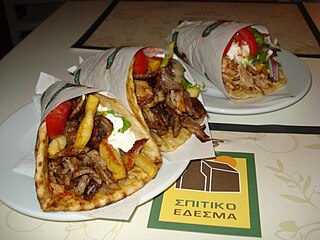
Midwestern cuisine is a regional cuisine of the American Midwest. It draws its culinary roots most significantly from the cuisines of Central, Northern and Eastern Europe, and Native North America, and is influenced by regionally and locally grown foodstuffs and cultural diversity.

Hungarian or Magyar cuisine is the cuisine characteristic of the nation of Hungary and its primary ethnic group, the Magyars. Traditional Hungarian dishes are primarily based on meats, seasonal vegetables, fruits, bread, and dairy products.

Gumbo is a soup popular in the U.S. state of Louisiana, and is the official state cuisine. Gumbo consists primarily of a strongly-flavored stock, meat or shellfish, a thickener, and the Creole "holy trinity" ― celery, bell peppers, and onions. Gumbo is often categorized by the type of thickener used, whether okra or filé powder.

Cambodian cuisine is an umbrella term for the cuisines of all ethnic groups in Cambodia, whereas Khmer cuisine refers specifically to the cuisine of the Khmer people. Over time, Cambodian cuisine has incorporated elements of Indian, Chinese and more recently French cuisine, and due to some of these shared influences and mutual interaction, it has many similarities with the neighbouring Thai, Vietnamese and Lao cuisines.

Iraqi cuisine or Mesopotamian cuisine is a Middle Eastern cuisine that has its origins from Sumerians, Akkadians, Babylonians, Assyrians and the other groups of the region.

A full-course dinner is a dinner consisting of multiple dishes, or courses. In its simplest form, it can consist of three or four courses; for example: first course, a main course, and dessert.

Rice vermicelli is a thin form of noodle. It is sometimes referred to as 'rice noodles' or 'rice sticks', but should not be confused with cellophane noodles, a different Asian type of vermicelli made from mung bean starch or rice starch rather than rice grains themselves.
The historical form of service à la russe is a manner of dining that involves courses being brought to the table sequentially, and the food being portioned on the plate by the waiter before being given to the diner. It became the norm in very formal dining in the Western world over the 19th century. It contrasts with the older service à la française in which all the food is brought out simultaneously, in an impressive display of tureens and serving dishes, and the diners put it on their plates themselves.

Afghan cuisine is influenced by Persian, Central Asian and Indian cuisines due to Afghanistan's close proximity and cultural ties. The cuisine is mainly based on Afghanistan's main crops, such as wheat, maize, barley, and rice. Accompanying these staple grains are native fruits, vegetables, and dairy products, such as milk, yogurt, whey, pomegranates, grapes, and sweet melons. Most of the people's diet revolve around rice-based dishes, while naan bread is consumed with most meals. Tea is generally consumed daily in large quantities, and is a major part of hospitality. The culinary specialties reflect the nation's ethnic and geographic diversity. The national dish of Afghanistan is Kabuli palaw, a rice dish cooked with raisins, carrots, nuts and lamb or beef.

Israeli cuisine comprises both local dishes and dishes brought to Israel by Jews from the Diaspora. Since before the establishment of the State of Israel in 1948, and particularly since the late 1970s, an Israeli Jewish fusion cuisine has developed.

Haitian cuisine consists of cooking traditions and practices from Haiti. It is a Creole cuisine that originates from a blend of several culinary styles that populated the western portion of the island of Hispaniola, namely the African, French, indigenous Taíno, Spanish and Arab influence. Haitian cuisine is comparable to that of "criollo" cooking and similar to the rest of the Latin Caribbean, but differs in several ways from its regional counterparts.

Dried shrimp are shrimp that have been sun-dried and shrunk to a thumbnail size. They are used in many East Asian, Southeast Asian and South Asian cuisines, imparting a unique umami taste. A handful of shrimp is generally used for dishes. The flavors of this ingredient are released when allowed to simmer.

Moldovan cuisine is a style of cooking related to the people of Moldova. It consists mainly of ingredients such as various meats, potatoes, cabbage, and a variety of cereal grains. The local cuisine is very similar to Romanian, and also draws inspiration and elements from other cuisines in the region, including Greek, Polish, Ukrainian, and Russian, with a great influence left by the Ottoman cuisine.

Javanese cuisine is the cuisine of Javanese people, a major ethnic group in Indonesia, more precisely the province of Central Java, Yogyakarta and East Java.
Lunch is a meal eaten around the middle of the day. It is commonly the second meal of the day, after breakfast, and varies in size by culture and region.

The BLT Cookbook is a cookbook about the preparation of bacon, lettuce, and tomato (BLT) sandwiches. It was written by Michele Anna Jordan and was published by William Morrow Cookbooks in the United States in June 2003. Jordan is a food writer and has written for The Press Democrat; The BLT Cookbook is her 14th published book. She researched the book for ten years and in the process she taste-tested hundreds of variations on the sandwich, describing it as America's most beloved sandwich. She instructs the reader on how to acquire and prepare the best ingredients for the sandwich. The book includes recipes with varying ingredients, though each recipe includes tomatoes. Many recipes in the book are not sandwiches, and include appetizers, soups, salads, and desserts. Jordan also suggests wines to accompany the sandwich.

Greek-American cuisine is the cuisine of Greek Americans and their descendants, who have modified Greek cuisine under the influence of American culture and immigration patterns of Greeks to the United States. As immigrants from various Greek areas settled in different regions of the United States and became "Greek Americans," they carried with them different traditions of foods and recipes that were particularly identified with their regional origins in Greece and yet infused with the characteristics of their new home locale in America. Many of these foods and recipes developed into new favorites for town peoples and then later for Americans nationwide. Greek-American cuisine is especially prominent in areas of concentrated Greek communities, such as Astoria, Queens and Tarpon Springs, Florida.
Bahamian cuisine refers to the foods and beverages of The Bahamas. It includes seafood such as fish, shellfish, lobster, crab, and conch, as well as tropical fruits, rice, peas, pigeon peas, and pork. Popular seasonings commonly used in dishes include chilies, lime, tomatoes, onions, garlic, allspice, ginger, cinnamon, rum, and coconut. Rum-based beverages are popular on the islands. Since the Bahamas consist of a multitude of islands, notable culinary variations exist.
Bistro Na's is a Michelin-starred Chinese restaurant in Temple City, California. The restaurant specializes in Chinese imperial cuisine.















